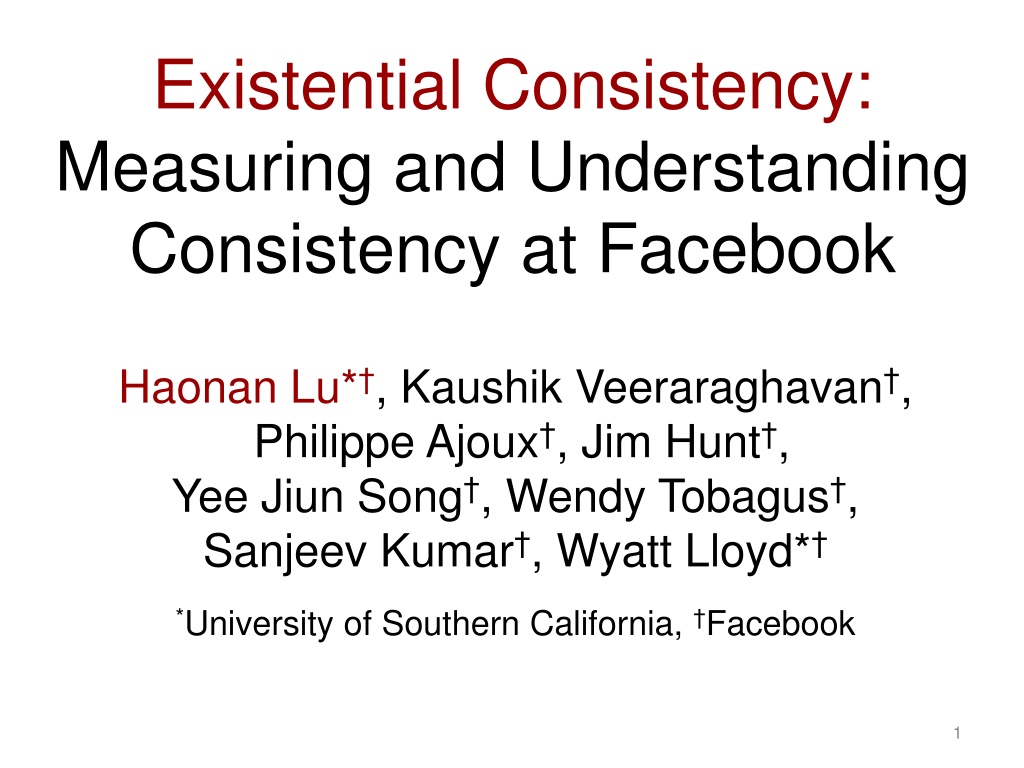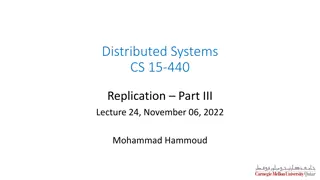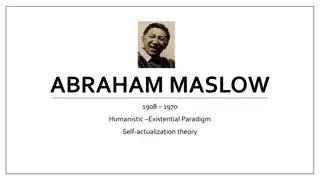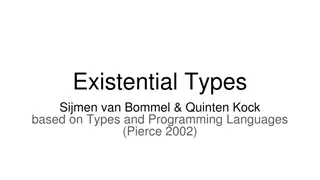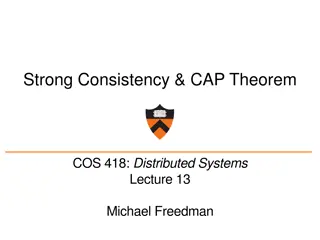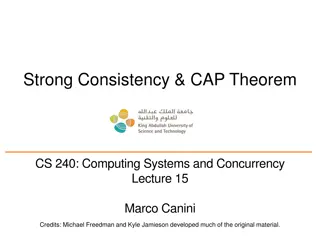Consistency at Facebook: A Study on Existential Consistency
This study explores the measurement and comprehension of consistency at Facebook, focusing on existential consistency. Key topics covered include consistency performance, fundamental tension between consistency and performance, anomalies in Facebook systems, and strategies for quantifying and preventing anomalies. The study delves into TAO, Facebook's large-scale production system, to investigate consistency issues and the impact on system behavior.
Download Presentation

Please find below an Image/Link to download the presentation.
The content on the website is provided AS IS for your information and personal use only. It may not be sold, licensed, or shared on other websites without obtaining consent from the author.If you encounter any issues during the download, it is possible that the publisher has removed the file from their server.
You are allowed to download the files provided on this website for personal or commercial use, subject to the condition that they are used lawfully. All files are the property of their respective owners.
The content on the website is provided AS IS for your information and personal use only. It may not be sold, licensed, or shared on other websites without obtaining consent from the author.
E N D
Presentation Transcript
Existential Consistency: Measuring and Understanding Consistency at Facebook Haonan Lu* , Kaushik Veeraraghavan , Philippe Ajoux , Jim Hunt , Yee Jiun Song , Wendy Tobagus , Sanjeev Kumar , Wyatt Lloyd* *University of Southern California, Facebook 1
Consistency Performance 4
Fundamental Tension Consistency Performance Eliminates anomalies (Oculus example) Makes systems easier to program Lower latency Higher throughput Difficult to quantify Simple to quantify First study of consistency in a large-scale, production system Facebook TAO 5
Anomaly: Unexpected Behavior Post Example Hey, I mentioned you in a post New post @Wyatt, you should check out this game! Read friend s timeline Old posts 6
Anomaly: Unexpected Behavior Oculus Example 1. Mine! yeah~ lucky! 1. I wouldn t mind 1. I wouldn t mind 2. Mine! yeah~ lucky! 7
Does Facebook have consistency anomalies? How many? What type? 8
TAO: Eventually Consistent Cache Vulnerability window: time during asynchronous replication when anomalies can happen new post read B done value A C old post M 9
Quantifying Anomalies How often do anomalies occur? Collect trace of requests to TAO What consistency would prevent them? Run anomaly checkers on the trace 10
Trace Collection Collect trace on web servers Challenges in tracing production system Volume of requests Time skew between web servers Missing requests 11
Challenge: Volume of Requests Billions of requests per second [ATC 13] Too many to log Sample on objects Object: vertex in social graph Log all requests to objects in sample Sufficient for local consistency models 12
Local Property Enables Sampling the system as a whole satisfies P whenever each individual object satisfies P. [1] Local consistency models can be checked on a per object basis Local Linearizability Per-Object Sequential Read-After-Write [1] M. P. Herlihy and J. M. Wing Linearizability: A Correctness Condition for Concurrent Objects. ACM TOPLAS, 1990 13
Challenge: Time Skew Time skew across web servers 99.9 percentile for 1 week: 35ms Add time skew to request s duration More overlapped requests Eliminates false positives 14
Logging Details Logged information: Start time Finish time Read or write Start time Finish time Read or write Value: match read with write Value: match read with write Determine real time ordering of requests Post (new) Sampling rate: 1 out of 1 million objects ~100% of requests to sampled objects 15
Trace Statistics 12 days (8/20 8/31) 17 million objects 3 billion requests 16
Check Trace for Anomalies Linearizability checker Paxos provides Per-Object Sequential checker PNUTS provides Read-After-Write checker TAO provides within a cluster 17
Linearizability Strongest non-transactional consistency Real-time constraint Post example Should return new Post (old) Post (new) Read (old) Haonan Haonan Wyatt Total order constraint Oculus example! 18
Linearizability Checker Graph captures state transitions Vertex: write operations Edge: real-time order Merge read with its write Captures state transitions seen by users Anomaly if merge causes a cycle Cycle indicates user s view system view 19
Linearizability Checker Captures real-time constraint Read should return new post instead Post (old) Post (new) Read (old) Haonan Haonan Wyatt Should return new post Post (new) Post (old) Read (old) Anomaly 20
More Complex Cases http://tinyurl.com/sosp15-demo w(0) r(1) w(1) w(2) w(3) 2 r(2) Anomalies r(3) r(3) r(2) r(1) 21
Result Overview Linearizability Per-Object Sequential Read-After-Write Bounds on non-local consistency models Anomalies found for all consistency models adopting them would have benefits 22
Linearizability Results 5 anomalies per million reads Prevented by Paxos-based implementation Upper bound on TAO anomalies Strongest consistency we checked TAO is highly consistent 23
Linearizability Results Real-Time Constraint Violations 4 per million reads Read Post (new) Post (new) starts Post (new) finishes B A M Replica A: Master M: Replica B: Read (old) 24
Linearizability Results Total Order Constraint Violations 1 per million reads Comment(W) Comment(H) B A Read (H) H finishes H starts M Replica A: Master M: W H Replica B: Read (W) W finishes W starts 25
Per-Object Sequential Results 1 anomaly per million reads Total order constraint User session constraint (1 per 10 million) Users should see their writes Read Post(new) B A Old M 26
Infer Bounds on Causal Linearizability 5 per million reads Superset of causal anomalies 5 per million reads Causal 1 per million reads Per-Object Sequential 1 per million reads Subset of causal anomalies 27
Lower Bounds on Transactions Strict Serializability > 5 per million reads Future research should provide transactions Linearizability 5 per million reads Causal with Transactions > 1 per million reads Causal Per-Object Sequential 1 per million reads 28
Real-Time Consistency Monitor Checkers cannot run in real-time -consistency Measure convergence of replicas A real-time health monitor Alarms when a replica falls behind 29
Conclusion Benefits of consistency are hard to quantify First study of a large-scale production system Measure Facebook s TAO system Collect trace and run anomaly checkers Real-world challenges Results TAO is highly consistent Benefits of adopting stronger consistency exist Research should provide transactions 30
